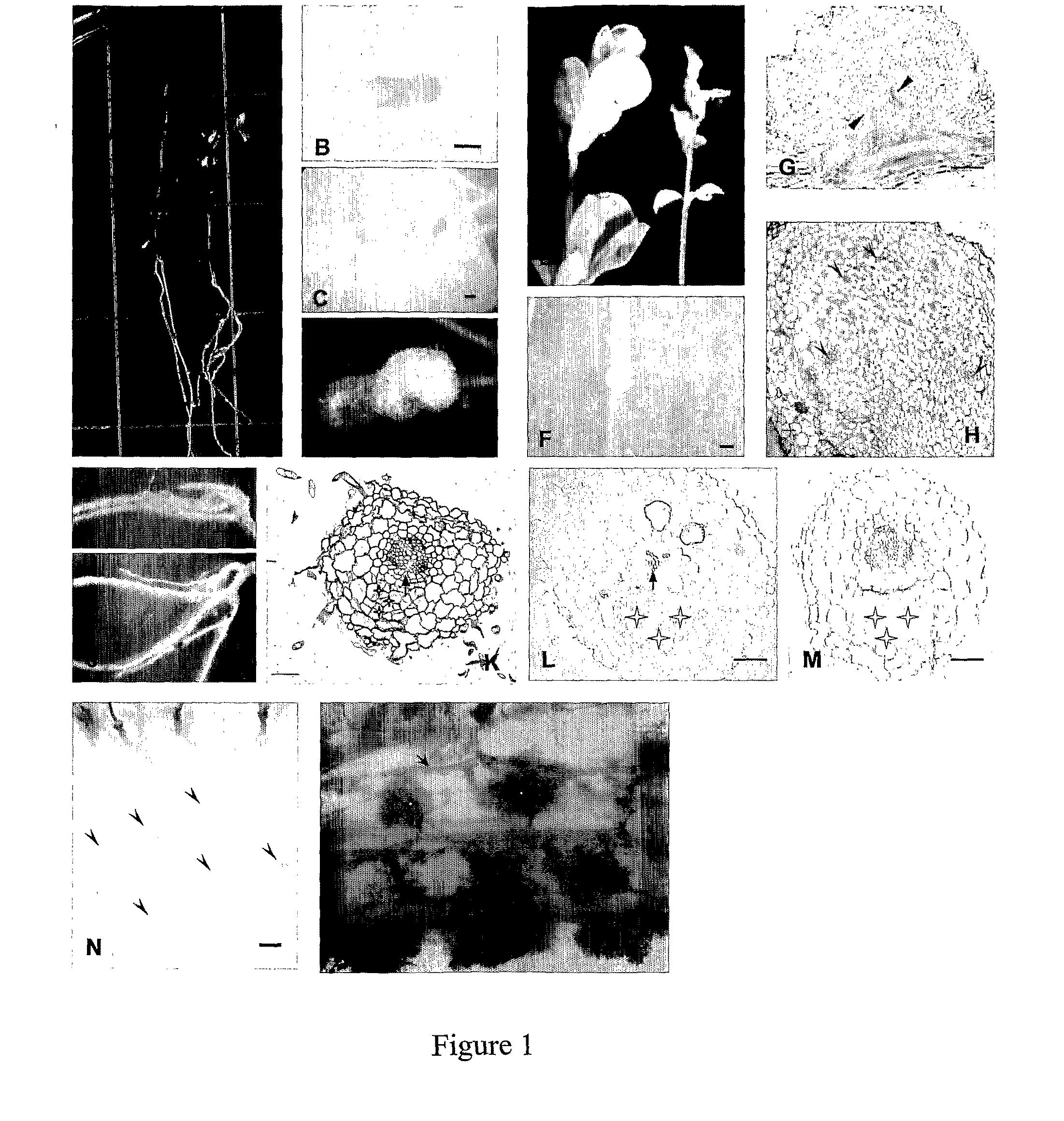Spontaneous nodulation in plants
a technology of plant nodulation and plant growth, applied in the direction of pteridophytes, angiosperms/flowering plants, enzymes, etc., can solve the problems of general limited growth of agricultural crops, and achieve the effect of reducing future use and negative environmental impa
- Summary
- Abstract
- Description
- Claims
- Application Information
AI Technical Summary
Benefits of technology
Problems solved by technology
Method used
Image
Examples
example 1
Isolation of Spontaneous Nodule Formation (snf) Mutants of Lotus japonicus
Six genetically stable spontaneous root nodule formation (snf) mutant lines of Lotus japonicus, isolated from a mutagenised population, are described. Large scale screening for snf mutants was performed in the model legume Lotus japonicus ecotype Gifu, which has a small diploid genome, particularly suited for genetic studies. Mutant screening was carried out on plants derived from an EMS mutagenised population known to produce mutants with high frequency (Perry et al., 2003 Plant Physiol. 131: 866-871), according to the following procedure.
A. Six Genetically Stable snf Mutant Lines of Lotus japonicus Isolated
Seeds of 2400 M3 pools, composed of seeds from 12665 independent M2 plants, were surface sterilised, as described previously (Handberg and Stougaard, 1992 Plant J., 2: 487-496), pre-soaked in sterile water overnight and germinated in a double-tray arrangement containing clay granules in the upper tray. The l
example 2
Growth, Development and Nodulation of Spontaneous Nodule Formation (snf1) Mutants of Lotus japonicus
A. snf1 Mutants have a Normal Growth Phenotype
The snf1 mutants of Lotus, more specifically snf1-5g belonging to the snf1 category, show normal growth and development to maturity, indicating an absence of pleiotropic effects of the snf1 mutation. When snf1 mutant plants are grown under axenic nitrogen-deficient conditions, they show symptoms of nitrogen-starvation, including anthocyanin accumulation in the stem, light green leaves and poor growth of the aerial part of the plants (FIG. 1A). Their nodules are white, round shaped and distributed on a normal looking root system (FIGS. 1A, B, C, F).
B. Nodules of Axenically Grown snf1 Mutants are Devoid of Rhizobia
The bacterial content of nodules of snf mutants was examined in order to confirm that spontaneous nodule formation was a plant mutant phenotype and not, for example, due to delayed infection from accidentally contaminating Rhizobium
example 3
Loss of Function Alleles of the Snf Locus
When inoculated with M. loti the gain of function (snf1-5g) mutants develop normal nitrogen fixing and bacteria filled root nodules. In contrast, loss of function allelic mutants, snf1-2, are non-nodulating, while leaky snf1-1 mutants regularly develop up to two functional nodules. Loss of function snf1 mutants retain the ability to perceive Nod-factors applied to their roots, as indicated by root hair swelling and root deformation and Ca2+ spiking, comparable to the response of wild type plants. This indicates that ‘loss of function’ and ‘gain of function’ snf mutations affect a component of the nodulation signal transduction pathway that is down-stream of Ca2+ spiking.
PUM
| Property | Measurement | Unit |
|---|---|---|
| Fraction | aaaaa | aaaaa |
| Volume | aaaaa | aaaaa |
| Digital information | aaaaa | aaaaa |
Abstract
Description
Claims
Application Information
 Login to view more
Login to view more - R&D Engineer
- R&D Manager
- IP Professional
- Industry Leading Data Capabilities
- Powerful AI technology
- Patent DNA Extraction
Browse by: Latest US Patents, China's latest patents, Technical Efficacy Thesaurus, Application Domain, Technology Topic.
© 2024 PatSnap. All rights reserved.Legal|Privacy policy|Modern Slavery Act Transparency Statement|Sitemap



